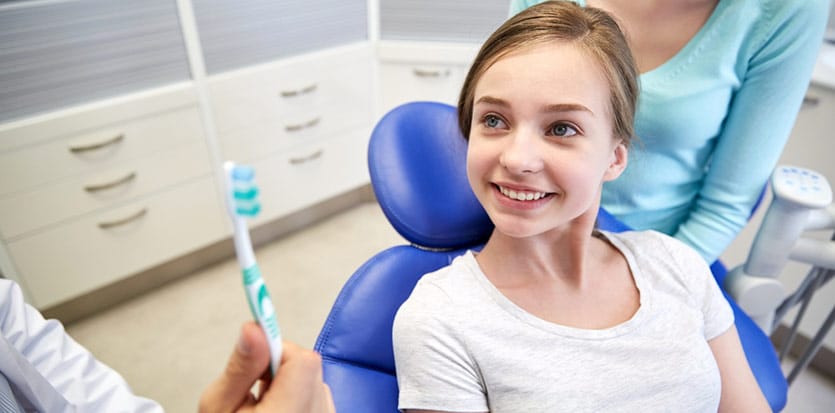We understand that scheduling your child’s first orthodontic consultation might bring with it several questions. In order to shed light on some of your concerns, read what our experienced orthodontists have to say on the matter of first consultations.
How is an Orthodontist Different from a General Dentist?

Sometimes, patients come into our office without a clear understanding of the difference between a general dentist and an orthodontist. To clarify, an orthodontist is a dentist first. All orthodontists first graduated from dental school. They then went on to specialize in orthodontics. The specialization typically involves a 2-3 year residency program that follows dental school. To summarize, we specialize in problems involving jaw or tooth positioning. This includes under bites, overbites, missing teeth, crowded teeth, extra teeth or misaligned teeth. We also help improve and correct other aesthetic or structural issues. We treat the most difficult aspects of orthodontics and with over 50 years of combined experience, we have become very well-versed in what we are doing.
Download Our Free Early Treatment Orthodontics Guide
Summary:
- Orthodontists are highly specialized dentists that underwent additional schooling for their specialty.
- We specialize in correcting problems involving jaw correction and proper positioning of the teeth.
At What Age Should I Visit The Orthodontist First?

The American Association of Orthodontists recommends that children be screened as early as age seven. An early orthodontic visit helps us identify contributing problems that might require additional orthodontics in the future. Not every patient who comes into the orthodontist’s office at age seven requires or commences with a course of treatment. However, it is wise to have an educated eye examine the patient to identify factors that may require early intervention.
The probability of successful treatment and definitive impact is higher with a younger patient than with an older one. Age should not be the only determinant, however. It is never too early to schedule your child’s first orthodontic consultation. Orthodontists are often the first line of defense in identifying overlooked issues like tongue dysfunction and breathing problems. Early detection and treatment of these issues is vital. We therefore encourage patients with complaints to visit an orthodontist, regardless of age.
Summary:
- According to the AAO, children should be examined by age seven, or sooner if necessary.
- Early intervention will ensure successful treatment of most orthodontic problems.
Why is the First Orthodontic Consultation So Important?

A child’s first orthodontic consultation is the most important one. An untreated mouth offers the best opportunity to identify the underlying causes of symptoms that might be contributing to the patient’s orthodontic problem. This enables us to take a holistic approach to any kind of treatment. If we focus only on how we will treat a malocclusion or poorly fitting teeth, we may miss signs of why the patient’s teeth are like that in the first place.
We try to be acutely cognizant of the overall condition of a child’s mouth. If we are not perceptive before starting treatment, the patient’s mouth becomes an altered environment. Identifying preexisting problems becomes more challenging in such a situation.
We feel that an individualized treatment plan is the most effective thing we offer. It all starts with the first orthodontic consultation. This is when we carefully evaluate a patient’s mouth to uncover their need for orthodontic intervention.
Summary:
- An orthodontist can identify problem areas best when we examine an untreated mouth.
- During the patients first visit, we investigate their mouth to determine whether they have a need for orthodontics.
Why Orthodontics?

The primary objective of orthodontics is straightforward: the achievement of a perfect bite. A perfect bite is one in which;
- There is a functional relationship between the upper and lower jaw.
- The teeth are staggered between one another, or fitting together like the teeth between gears.
With this relationship, orthodontists hope to achieve optimal functional stability for the patient’s teeth and musculature. Or simply put, the perfect bite! An added benefit of orthodontic treatment is that it creates a foundation for future dental work. This enables future restorative dentists to do their best work. We ultimately seek to achieve functional stability in the musculature including functions that occur inside the oral cavity like breathing and swallowing.
Orthodontic treatment goes beyond the treatment of teeth to include the added benefit of enhanced aesthetics. Many patients tend to seek our care to improve aesthetic quality. In reality, our treatments are geared toward functional aspects; the aesthetic aspect is a byproduct.
Summary:
- Orthodontists strive to achieve functional and structural stability in the mouth.
- Improvements to the aesthetic quality of the mouth and facial structure are a beneficial byproduct of good orthodontic treatment.
If you are ready to take the first step towards giving your child the perfect smile, contact one of our five convenient locations throughout Western New York and get started with our highly skilled and experienced team of dedicated Buffalo orthodontists.
Download Our Free Early Treatment Orthodontics Guide

